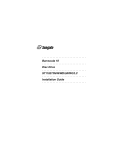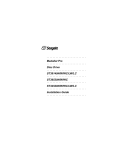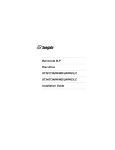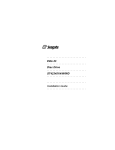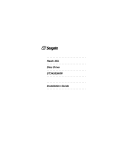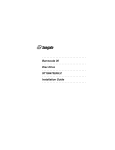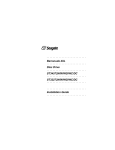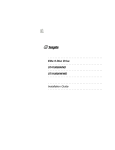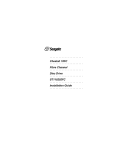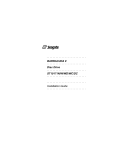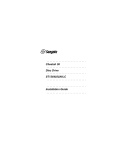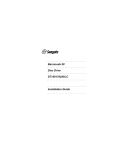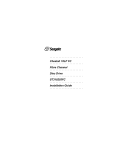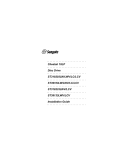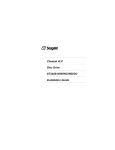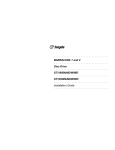Download Seagate ST34502LW/LC Installation guide
Transcript
• • • • • • • • • • • • • • • • • • • • • • • • • • Cheetah 9LP • • • • • • • • • • • • • • • • • • • • • • • • • • • • • • • • • • • • • • • • • • • • • • • • • • • • • • • • • • • • • • • • • • • • • • • • • • • • • • • • Disc Drive • • • • • • • • • ST39102LW/LC • • • • • • • • • • • • • ST34502LW/LC • • • • • • • • • • • • • Installation Guide • • • • • • • • • • • • • • • Contents Preface ..................................................................................... 1 Electrostatic discharge protection ............................................ 1 Important safety information and precautions .......................... 2 Wichtige Sicherheitshinweise ................................................... 4 Regulatory agency compliance ................................................ 7 Seagate Technology support services...................................... 9 General description ................................................................ 15 Initial setup information .......................................................... 19 Kühlung des Systems............................................................. 29 Installation des Laufwerkes und Anschluß der Kabel............. 31 LW drives section ................................................................... 40 LC drives section .................................................................... 46 ©1997, 1998 Seagate Technology, Inc. All rights reserved Publication Number: 83329230, Rev. B May 1998 Seagate, Seagate Technology, and the Seagate logo are registered trademarks of Seagate Technology, Inc. Cheetah, SeaFAX, SeaFONE, SeaBOARD, and SeaTDD are either trademarks or registered trademarks of Seagate Technology, Inc. or one of its subsidiaries. All other trademarks or registered trademarks are the property of their respective owners. No part of this publication may be reproduced in any form without written permission from Seagate Technology, Inc. Cheetah 9LP Installation Guide, Rev. B 1 Preface This manual contains information for users of the Seagate® Cheetah 9LP SCSI disc drives. It provides support services, performance specifications, and initial setup information. Additional information is available in the Cheetah 9LP Product Manual (part number 83329240). Contact your Seagate sales representative if you need to order this publication. Electrostatic discharge protection Caution. Removal of circuit boards by personnel not performing depot repair will damage components and may void the warranty. All drive electronic assemblies are sensitive to static electricity, due to the electrostatically sensitive devices used within the drive circuitry. Although some devices such as metal-oxide semiconductors are extremely sensitive, all semiconductors, as well as some resistors and capacitors, may be damaged or degraded by exposure to static electricity. Electrostatic damage to electronic devices may be caused by the direct discharge of a charged conductor or by exposure to the static fields surrounding charged objects. To avoid damaging drive electronic assemblies, observe the following precautions when installing or servicing the drive: • Ground yourself to the drive whenever the drive electronics are or will be exposed. Connect yourself to ground with a wrist strap (Seagate part number 12263496). Connection may be made to any grounded metal assembly. As a general rule, remember that you and the drive electronics must all be grounded to avoid potentially damaging static discharges. 2 Cheetah 9LP Installation Guide, Rev. B • Turn off the power before removing or installing the DC power cable. • Do not remove any circuit boards from the drive. • Never use an ohmmeter on any circuit boards. • When installing the drive on a carrier or tray, discharge the carrier or tray prior to inserting it into the system. Important safety information and precautions Caution. Use forced-air ventilation when bench-testing the drive to ensure proper cooling of drive components. Use proper safety techniques for safe, reliable operation of this unit. The procedures in this manual and labels on the unit contain warnings and cautions that must be carefully read and followed to minimize or eliminate the risk of personal injury. The warnings point out conditions or practices that may endanger you or others. The cautions point out conditions or practices that may damage the unit, possibly making it unsafe for use. Always observe the following warnings and precautions: • Follow all cautions and warnings in the procedures. • Use sound safety practices when operating, installing, or removing the unit. • Use caution when troubleshooting a unit that has voltages present. Turn off power to the unit before removing it. • Ensure that the internal temperature of the rack or cabinet does not exceed the limits defined for the drive when the drive is mounted in an equipment rack or cabinet. When units are Cheetah 9LP Installation Guide, Rev. B • • • • 3 stacked vertically, pay special attention to the top where temperatures are usually highest. Follow the precautions listed above in “Electrostatic discharge protection.” Do not remove any circuit boards from the drive. Return the entire drive for depot repair if any circuit board is defective. Removal of circuit boards by personnel not performing depot repair will damage components and may void the warranty. Do not separate the head and disc assembly (HDA) from the PCB. Return the entire drive for depot repair if the HDA is defective. Do not attempt to disassemble the HDA. It is not field repairable. If the sealed HDA is opened by personnel not performing depot repair, this will damage components and void the warranty. As a component, this drive is designed to be installed and operated in accordance with UL1950, EN60950, CAN/CSA C22.2 950-M95, and VDE0805. Seagate takes all reasonable steps to ensure that its products are certifiable to currently accepted standards. Typical applications of these disc drives include customer packaging and subsystem design. Safety agencies conditionally certify component assemblies, such as the Cheetah disc drive, based on their final acceptability in the end-use product. The subsystem designers are responsible for meeting these conditions of acceptability in obtaining safety-regulatory agency compliance in their end-use products and for certifying where required by law. A necessary part of meeting safety requirements is the provision for overcurrent protection on drive SELV supply voltages. 4 Cheetah 9LP Installation Guide, Rev. B This unit is a component part and as such is not meant to comply with FCC or similar national requirements as a stand-alone unit. Engineering radiated emissions test results are available through the Seagate Safety Department to assist the subsystem designer. Wichtige Sicherheitshinweise Vorsicht. Beim Testen des Laufwerks auf dem Prüftisch ist Fremdbelüftung vorzusehen, um eine ausreichende Kühlung der Laufwerkkomponenten sicherzustellen. Verwenden Sie geeignete Sicherheits- um den sicheren, zuverlässigen Betrieb dieser Einheit zu gewährleisten. Die Verfahren in diesem Handbuch und die Aufkleber auf dem Gerät enthalten Warn- und Vorsichtshinweise. Diese Hinweise sind sorgfältig durchzulesen und zu beachten, um das Risiko von Verletzungen auf ein Mindestmaß zu beschränken oder ganz zu vermeiden. Die Warnhinweise machen auf Situationen oder Praktiken aufmerksam, die Sie oder andere gefährden könnten. Die Vorsichtshinweise machen auf Situationen oder Praktiken aufmerksam, die Einheit beschädigen können, so daß deren Gebrauch mit Risiko behaftet ist. Die Warn- und Vorsichtshinweise sind nicht allumfassend! Es ist uns einfach nicht möglich, alle Wartungsmethoden oder die eventuellen Risiken jeder Methode zu kennen, zu beurteilen und Sie entsprechend zu beraten. Aus diesem Grund haben wir auf eine derartige umfassende Beurteilung verzichtet. Falls Sie ein hier nicht beschriebenes Verfahren oder Werkzeug verwenden, stellen Sie zuerst sicher, daß das gewählte Verfahren weder Ihre persönliche Sicherheit noch die Leistung der Einheit gefährdet. Cheetah 9LP Installation Guide, Rev. B 5 Beachten Sie in jedem Fall die folgenden Warn-und Vorsichtshinweise: • Beachten Sie alle Warn- und Vorsichtshinweise in diesem Handbuch. • Treffen Sie beim Betrieb, bei der Installation oder bei der Entfernung der Einheit angemessene Sicherheitsvorkehrungen. • Wenn eine Einheit unter Spannung steht, gehen Sie bei der Fehlerdiagnose besonders vorsichtig vor. Schalten Sie die Einheit aus, bevor Sie mit den Installations-und Entfernungsarbeiten beginnen. • Wenn das Laufwerk in einem Einbaugestell oder Gehäuse montiert ist, sorgen Sie dafür, daß die Temperatur im Inneren des Gestells oder Gehäuses die für das Laufwerk vorgegebenen Grenzwerte nicht übersteigt. Wenn Einheiten vertikal übereinander betestigt werden, achten Sie besonders auf den oberen Stapelbereich, da dort die Temperatur gewöhnlich am höchsten ist. • Befolgen Sie die oben unter “Electrostatic Discharge Protection” angegebenen Sicherheitsmaßnahmen. • Nehmen Sie keine Platinen aus dem Laufwerk. Wenn eine Platine defekt ist, muß das gesamte Laufwerk zur Reparatur eingeschickt werden. Die Herausnahme von Platinen durch andere Personen als die für die werkseitige Reparatur zuständigen kann zu einer Beschädigung der Komponenten und Erlöschen des Garantieanspruchs führen. 6 Cheetah 9LP Installation Guide, Rev. B • Die vormontierte Kopf- und Festplatteneinheit (HDA) nicht aus dem Laufwerkgehäuse nehmen! Falls die HDA beschädigt ist, schicken Sie das gesamte Laufwerk zur Reparatur ein. • Die HDA ist nicht vor Ort reparierbar und darf nicht auseinandergenommen werden! Öffnen der versiegelten HDA durch andere Personen als die für die werkseitige Reparatur zuständigen hat eine Beschädigung der Komponenten und Erlöschen des Garantieanspruchs zur Folge. Als Teilkomponente ist dieses Laufwerk für die Installation und den Betrieb in Übereinstimmung mit UL 1950, EN60950, CAN\CSA C22.2 950-M95 und VDE0805 vorgesehen. Seagate ist ständig bemüht, die Zulassungsfähigkeit von Seagate-Produkten im Rahmen der gegenwärtig geltenden Standards zu gewährleisten. Zu den typischen Anwendungen dieser Festplattenwerke zählen Systemeinbau durch den Kunden und die Konstruktion von Untersystemen. Sicherheitsbehörden gewähren eine bedingte Zulassung für Komponenten wie das Cheetah-Festplattenlaufwerk vorbehaltlich der endgültigen Zulasssung im Endprodukt. Designer von Untersystemen sind dafür verantwortlich, die Voraussetzungen für die Einhaltung sicherheits- oder aufsichtsbehördlicher Vorschriften in ihren Endprodukten und - falls gesetzlich vorgeschrieben - für die Zulassung zu schaffen. Eine Grundvoraussetzung zur Einhaltung der Sicherheitsanforderungen ist die Bereitstellung eines Überlastschutzes für die SELV-Versorgungsspannungen des Laufwerks. Dieses Gerät ist eine Baugruppe und unterliegt als solche nicht den Anforderungen der FCC oder ähnlicher nationaler Behörden für eigenständige Geräte. Technische Testergebnisse zu elektro- Cheetah 9LP Installation Guide, Rev. B 7 magnetische Strahlung sind für Designer von Untersystemen auf Anfrage von der Seagate-Sicherheitsabteilung erhältlich. Regulatory agency compliance Electromagnetic susceptibility As a component assembly, the drive is not required to meet any susceptibility performance requirements. It is the responsibility of those integrating the drive within their systems to perform those tests required and design their system to ensure that equipment operating in the same system as the drive or external to the system does not adversely affect the performance of the drive. See DC power requirements on page 18. Electromagnetic compliance Seagate uses an independent laboratory to confirm compliance to the directives/standard(s) for CE Marking and C-Tick Marking. The drive was tested in a representative system for typical applications. The selected system represents the most popular characteristics for test platforms. The system configurations include: • 486, Pentium, and PowerPC microprocessors • 3.5-inch floppy disc drive • Keyboard • Monitor/display • Printer • External modem • Mouse Although the test system with this Seagate model complies to the directives/standard(s), we cannot guarantee that all systems will comply. The computer manufacturer or system integrator 8 Cheetah 9LP Installation Guide, Rev. B shall confirm EMC compliance and provide CE Marking and CTick Marking for their product. Electromagnetic compliance for the European Union If this model has the CE Marking it complies with the European Union requirements of the Electromagnetic Compatibility Directive 89/336/EEC of 03 May 1989 as amended by Directive 92/31/ EEC of 28 April 1992 and Directive 93/68/EEC of 22 July 1993. Australian C-Tick If this model has the C-Tick Marking it complies with the Australia/New Zealand Standard AS/NZS3548 1995 and meets the Electromagnetic Compatibility (EMC) Framework requirements of Australia’s Spectrum Management Agency (SMA). Cheetah 9LP Installation Guide, Rev. B 9 Seagate Technology support services Presales support To determine which Seagate products are best suited for your specific application, contact us about configuration and compatibility and for current product availability. You can leave a voice message after business hours or send an e-mail message—we reply during business hours. Disc Drives 405-936-1210 Fax: 405-936-1683 (8:00 A.M. to 12:15 P.M., 1:30 P.M. to 6:00 P.M., central time, M-F) e-mail: [email protected] Tape Products 1-800-626-6637 or 714-641-2500 Fax: 714-641-2410 (6:00 A.M. to 5:00 P.M., pacific time, M-F) e-mail: [email protected] Note. You can purchase select tape products and tape accessories through Seagate Express 24 hours daily by calling 1-800-531-0968 or by faxing your order to 972-481-4812. Technical support services If you need assistance installing your drive, consult your dealer. Dealers are familiar with their unique system configurations and can help you with system conflicts and other technical issues. If you need additional assistance with your Seagate® drive or other Seagate products, use one of the Seagate technical support services listed below. SeaFONE® 1-800-SEAGATE Seagate’s 800 number (1-800-732-4283) allows toll-free access to automated self-help services, providing answers to commonly 10 Cheetah 9LP Installation Guide, Rev. B asked questions, troubleshooting tips, and specifications for disc drives and tape drives. This service is available 24 hours daily and requires a touch-tone phone. International callers can reach this automated self-help service by dialing 405-936-1234. Online services Using a modem, you can obtain troubleshooting tips, free utility programs, drive specifications and jumper settings for Seagate’s entire product line. You can also download software for installing and analyzing your drive. SeaNET You can obtain technical information about Seagate products over the Internet from Seagate’s World Wide Web home page (http://www.seagate.com) or Seagate’s ftp server (ftp:// ftp.seagate.com). You can also send E-mail with your questions t o D i s cS u p p o r t @ S e ag a te . co m o r Ta p eS u p p o r t @ Seagate.com. SeaBOARD® SeaBOARD is a computer bulletin board system that contains information about Seagate disc and tape drive products and is available 24 hours daily. Set your communications software to eight data bits, no parity, and one stop bit (8-N-1). Location Phone number Australia France Germany Taiwan Thailand 61-2-9756-2359 33 1-48 25 35 95 49-89-140-9331 886-2-2719-6075 662-531-8111 Cheetah 9LP Installation Guide, Rev. B Location Phone number UK USA 44-1628-478011 Disc: 405-936-1600; Tape: 405-936-1630 11 FAX services SeaFAX® You can use a touch-tone telephone to access Seagate’s automated FAX system to receive technical support information by return FAX. This service is available 24 hours daily. Location Phone number Australia Germany UK USA 61-2-9756-5170 49-89-1430-5102 44-1628-894084 Disc: 405-936-1620; Tape: 405-936-1640 Technical support FAX You can FAX questions or comments to technical support specialists 24 hours daily. Responses are sent during business hours. Location Phone number Australia France Germany Hong Kong Japan Korea Singapore Taiwan 61-2-9725-4052 33 1-46 04 42 50 49-89-1430-5100 852-2368 7173 81-3-5462-2979 82-2-556-4251/7395 65-488-7528 886-2-2715-2923 12 Cheetah 9LP Installation Guide, Rev. B Location Phone number UK USA 44-1628-890660 Disc: 405-936-1685; Tape: 405-936-1683 Direct-support services Technical support For one-on-one help, you can talk to a technical support specialist during local business hours. Before calling, note your system configuration and drive model number (ST xxxx). Location Phone number Australia 61-2-9725-3366 (9:00 A.M. to 5:00 P.M., eastern time, M–F) 33 1-41 86 10 86 (9:30 A.M. to 12:30 P.M., 2:00 P.M. to 5:00 P.M., M–F) Disc: 49-89-140-9332; Tape: 49-89-140-9333 (9:30 A.M. to 12:30 P.M., 2:00 P.M. to 4:00 P.M., M–F) 852-2368 9918 82-2-531-5800 (9:00 A.M. to 12:00 P.M., 1:00 P.M. to 6:00 P.M., M–F) 65-488-7584 (9:00 A.M. to 12:00 P.M., 2:00 P.M. to 5:00 P.M., M–F) 886-2-2514-2237 44-1628-894083 (10:00 A.M. to 1:00 P.M., 2:00 P.M. to 5:00 P.M., M–F) Please dial 1-800-SEAGATE or 405-936-1234 for the specific product telephone number. (8:00 A.M. to 12:15 P.M., 1:30 P.M. to 6:00 P.M., central time, M–F) France Germany Hong Kong Korea Singapore Taiwan UK USA Cheetah 9LP Installation Guide, Rev. B 13 SeaTDD™ 405-936-1687 Using a telecommunications device for the deaf (TDD), you can send questions or comments 24 hours daily and exchange messages with a technical support specialist between 8:00 A.M. to 12:15 P.M. and 1:30 P.M. to 6:00 P.M. (central time) Monday through Friday. Customer service centers Seagate direct OEM, Distribution, and Systems Integrator customers should contact their Seagate service representative for warranty information. Other customers should contact their place of purchase. Seagate offers comprehensive customer support for all Seagate drives. These services are available worldwide. Location Phone number FAX number Asia Pacific and Australia Europe, Middle East, and Africa Japan USA Other Americas (Brazil, Canada, Mexico) 65-485-3595 65-488-7503 31-2031-67300 81-3-5462-2904 1-800-468-3472 31-2065-34320 81-3-5462-2979 405-949-6740 405-949-6706 405-949-6738 Manufacturer’s representatives Brazil MA Informatica 55-21-516-6649 Canada Memofix 905-660-4936 Adtech 905-812-8099 1-800-624-9857 55-21-516-5280 905-660-8738 905-812-7807 14 Cheetah 9LP Installation Guide, Rev. B Location Phone number FAX number Mexico Abicom Seamax SA DE CV Southern Europe Caesar Italia 525-546-4888 525-546-4888 39-688-18149 39-688-02103 Cheetah 9LP Installation Guide, Rev. B 15 General description Cheetah 9LP SCSI disc drives are high-speed, random-access digital-data storage devices capable of operating in single-ended (SE) or low voltage differential (LVD) modes. These two modes are offered to allow you to use this drive in systems that use the traditional SE technology or to use it in LVD-capable systems. Refer to page 20 for additional information about LVD technology. The drive is a component for installation in an enclosure designed for the drive. This is often a rack within the system or an external enclosure designed to house one or more disc drives or other peripheral units. In either case, the disc drive must receive adequate cooling (refer to “Providing adequate cooling”) and it must be sufficiently grounded and shielded from emissions. The Cheetah 9LP Product M anual (par t number 83329240) contains gui deli nes for a properly designed enclosure. Attention. This high performance Cheetah disc drive must have proper power and cooling for reliable operation. 16 Cheetah 9LP Installation Guide, Rev. B Figure 1. Cheetah 9LP family drive (LW model shown) Cheetah 9LP Installation Guide, Rev. B Characteristics ST39102LW/LC SCSI1 17 ST34502LW/LC Ultra2 SCSI1 Interface Ultra2 Capacity Unformatted (Gbytes) Formatted (Gbytes)2 11.27 9.17 5.63 4.55 Recording Cylinders (user) Read/write data heads Avg bytes/track 6,962 12 104,840-159,008 6,962 6 104,840-159,008 Access time3 Average read (msec) Average write (msec) 5.4 6.2 5.4 6.2 Disc rotation RPM Average latency (msec) 10,025 2.99 10,025 2.99 Synchronous data transfer rate Maximum instantaneous 40 (SE mode) (Mbytes/sec) 80 (LVD mode) Asynchronous data transfer rate Maximum instantaneous (2 bytes wide) (Mbytes/sec) Multi-segmented cache (kbytes) 1. 2. 3. 40 (SE mode) 80 (LVD mode) 10.0 10.0 1,024 standard 4,096 optional 1,024 standard 4,096 optional Also operates per SCSI-1/SCSI-2/SCSI-3 protocols. The specified formatted capacities are calculated with the standard OEM sector size (512 bytes per logical block) and sparing. Includes on-board controller overhead. 18 Cheetah 9LP Installation Guide, Rev. B Single-ended (SE) mode Low voltage differential (LVD) mode DC power requirements (±5%)1 +5 V +12 V +5 V +12 V ST39102LW/LC Maximum start current Maximum operating current Average idle current 0.94A 1.02A 0.78A 1.7A 0.84A 0.60A 0.96A 1.09A 0.80A 1.7A 0.84A 0.60A ST34502LW/LC Maximum start current Maximum operating current Average idle current 0.84 0.85 0.71 1.7 0.60 0.39 0.86 0.93 0.73 1.7 0.60 0.39 1. For more detailed power information, refer to the Cheetah 9LP Product Manual, publication number 83329240. Cheetah 9LP Installation Guide, Rev. B 19 Initial setup information The general information beginning on this page applies to all of the Cheetah 9LP drive models. After reading the general information topics, refer to the appropriate drive-specific section listed below for additional information about configuring and installing your particular model. Drive models Page ST39102LW and ST34502LW 40 ST39102LC and ST34502LC 46 General information The following general information topics are discussed: • • • • • • • • • Single-ended and low voltage differential modes SCSI ID jumpers Drive termination Terminator power Interface drivers and data path width notes Other applicable jumper options Providing adequate cooling Mounting the drive and connecting cables 1 Formatting the drive 1This mounting procedure does not apply to “LC” model drives. To mount an “LC” drive, plug the drive into the system’s single connector attachment (SCA) position on the system’s back panel. 20 Cheetah 9LP Installation Guide, Rev. B Single-ended and low voltage differential modes This drive incorporates two different transceivers to allow you to use it in traditional systems which may use single-ended (SE) drivers and receivers, or to use it in low voltage differential (LVD) capable systems which use LVD drivers and receivers. You can configure the drive to switch between SE and LVD modes automatically or force it to operate in SE mode only. To configure this option, use the jumper illustrations on page 43 (LW models) or page 48 (LC models). LVD technology enhances parallel SCSI I/O performance, reduces power consumption, increases allowable cable lengths, and improves device connectivity beyond SE capabilities. Note. To operate at the Ultra2 SCSI rates in LVD mode, all devices on the same bus must be running in LVD mode. If you add any single-ended device to a bus that is operating in LVD mode, all devices drop back to operating in single-ended mode. This eliminates the possibility of reaching Ultra2 SCSI transfer rates. Warning. Do not mix LVD drives on the same daisy chain with devices having high voltage differential (HVD) interface circuits. SCSI ID jumpers Each device on the SCSI chain must have a unique SCSI ID. The host system’s SCSI controller usually uses the ID that has the highest priority interrupt in the SCSI I/O system. This is always ID7. ID0 has the lowest priority in an 8-bit I/O system. ID8 has the lowest priority in a 16-bit I/O system. The lower priority Cheetah 9LP Installation Guide, Rev. B 21 SCSI IDs are normally used for other SCSI devices such as this Cheetah disc drive. Note. Most SCSI controllers (host adapters) allow you to skip a SCSI ID. For example, you can have ID0, ID1, and ID3 (skipping ID2). Other controllers do not allow this so be sure to refer to your system or controller user’s manual for details about its requirements for proper SCSI device installation. Note. This drive is SCAM (SCSI Configured Auto Magically) compliant. If the system into which you are installing this drive requires SCAM compliant drives, you do not need to be concerned about the drive ID jumper settings, as the system automatically assigns your new drive the ID it wants it to have. The system may or may not use the existing drive ID jumper settings. Setting the drive ID doesn’t hurt anything, but is not necessary in a SCAM compliant system. Most Cheetah disc drives are factory set with the SCSI ID set at 0. To change the SCSI ID, refer to the appropriate drive section for your model. If, after completing the installation process, the drive’s LED does not show on/off activity when the host is trying to communicate with the drive, a duplicate SCSI ID may be the problem. If this is the case, change the ID so that each device on the SCSI chain has its own unique ID. Also check your system or controller user’s manual to ensure that you have not violated its SCSI ID numbering recommendations. 22 Cheetah 9LP Installation Guide, Rev. B Drive termination If you are installing a Cheetah drive in a system that has other SCSI devices installed, terminate only the end devices on the SCSI chain. A SCSI “device” is any disc drive, scanner, tape backup unit, or other piece of hardware connected to your system using the SCSI bus. Note. Use active (ANSI SCSI-2 Alternative 2) single-ended terminators when terminating a bus operating in singleended mode. Use SPI-2-compliant active low voltage differential terminators when terminating a SCSI Ultra2 bus operating in LVD mode. The top example in Figure 2 shows an internal hard disc at one end of the SCSI bus with the SCSI controller at the other end (both are terminated). The bottom example shows two additional SCSI devices connected externally—this means the SCSI controller is no longer on the end of the SCSI chain and should not be terminated. Note. Some controllers prefer to remain terminated even if they are in the middle of the chain. Also, some controllers treat the internal and external chains as separate logical buses. This means you may need to terminate both the first and last devices on both logical buses to achieve proper termination. If necessary, refer to your system or controller documentation to see how this is handled in your particular system. These drives do not have on-board terminators, so you must terminate external to the drive when termination is required. For ST39102LC and ST34502LC drives, this is normally accom- Cheetah 9LP Installation Guide, Rev. B 23 plished by terminating the bus at the backpanel. For ST39102LW and ST34502LW drives, use an in-line terminator on the cable. Internal SCSI cable Internal SCSI device Internal SCSI device Controller Terminate Internal SCSI cable Internal SCSI device Internal SCSI device Controller External SCSI cable External SCSI device External SCSI device Terminate Figure 2. SCSI bus termination Terminator power You usually will not need to change this option and can normally leave the drive configured as it was shipped from the factory. For information about how to change the terminator power option on your drive, refer to the appropriate drive-specific section. I/O circuits and data path widths • These drives can be used in single-ended or low voltage differential interface systems; however, do not attempt to mix these drives on the same daisy chain with high voltage differential devices. The circuits are not compatible and drive damage may occur. • These drives have a “wide” (16-bit) SCSI data bus rather than the standard (non-wide) 8-bit SCSI data bus; however, you can 24 Cheetah 9LP Installation Guide, Rev. B use these wide drives on a standard (non-wide) 8-bit data bus if you provide proper termination to the upper 8-bit data lines. This is often referred to as providing “high-9 termination.” Figures 3, 4, and 5 show typical drive connections. The following table lists the maximum cable lengths and number of devices using single-ended and LVD I/O circuits allowed on a daisy-chain cable for 10, 20, and 40 Mtransfers/sec I/O data transfer rates. Table 1. Cable characteristics for SE and LVD circuits Maximum number of devices on bus SCSI driver type I/O transfer rate (Mtransfers/s) SE 10 16 6 meters (19.7 ft.) SE 20 4 3 meters (9.8 ft.) SE 20 8 1.5 meters (4.9 ft.) LVD 40 16 12 meters (39.4 ft.) Maximum cable length allowed A maximum of 16 devices can be connected on a 16-bit wide data bus. Cheetah 9LP Installation Guide, Rev. B Figure 3. 68-pin I/O connection to drive (LW model) Figure 4. 80-pin I/O connection to drive (LC model) 25 26 Cheetah 9LP Installation Guide, Rev. B “LW” Model Drive Note: Do not mix “LW” and “WD” model drives on the daisy chain. Terminator [2] 2 through X SCSI devices [1] Pin 1 (check your adapter for Pin 1 location) SCSI ID 1 SCSI ID 7 SCSI ID 0 Terminated Host Adapter PCB [1] “X” means up to 15 or the maximum allowable number of devices on the SCSI bus. See system documentation and Table 1. [2] External terminator. Used only on end “LW” drive. Use only SPI-2compliant active LVD terminators on SCSI Ultra2 buses. Figure 5. Multiple-drive connection to host adapter Cheetah 9LP Installation Guide, Rev. B 27 80-pin SCSI I/O Connector Pin 1 J2 J6 Note. This drive model plugs directly into a backplane connector and therefore uses no cables. Figure 6. Drive model “LC” with single 80-pin I/O and power connector 28 Cheetah 9LP Installation Guide, Rev. B Providing adequate cooling The enclosure design must ensure adequate cooling for the drive. The maximum ambient temperature allowed is 50°C. The drive’s product manual (83329240) describes how to evaluate the air-flow design. The evaluation consists of ensuring that the case temperature of certain critical components remains within acceptable limits during drive operation. We recommend orienting the drive or directing the air flow in a way that creates the least amount of air-flow resistance while providing air flow above the circuit boards and around the head and disc assembly (HDA). Also, choose the shortest possible path between the air inlet and exit. This minimizes the distance traveled by air that is heated by the drive and by other nearby heat sources. Figure 7 shows two design approaches with one or more fans used to generate air flow. The air-flow patterns can be created by the fans either pushing or drawing air. The overall flow pattern can be directed from front to back, back to front, or side to side. Cheetah 9LP Installation Guide, Rev. B 29 Kühlung des Systems Die Gehäusekonstruktion muß eine ausreichende Kühlung des Laufwerkes gewährleisten. Die Umgebungstemperatur darf maximal 50°C betragen. Die Produkthandbuch Cheetah 9LP (Dokument 83329240) enthalten Anweisungen zur Beurteilung der Luftstromkonstruktion. Die Beurteilung muß sicherstellen, daß sich die Gehäuset e m p e r a t u r b e s t i m m t e r k r i t i s c h e r Ko m p o n e n t e n b e i Laufwerkbetrieb innerhalb zugelassener Grenzen hält. Wir empfehlen, das Laufwerk so zu orientieren oder den Luftstrom so zu lenken, daß der geringste Luftstromwiderstand erzeugt wird und gleichzeitig ein Luftstrom über den Platinen und um die Kopf- und Festplatteneinheit (HDA) gegeben ist. Wählen Sie einen möglichst kurzen Weg zwischen Lufteinlaß und -auslaß. Dadurch wird die Strecke, die die vom Laufwerk und anderen nahegelegenen Hitzequellen aufgewärmte Luft zurücklegt, auf ein Minimum beschränkt. Abbildung 7 zeigt zwei Konstruktionsmöglichkeiten, bei denen ein oder mehrere Lüfter den Luftstrom erzeugen. Der Luftstromverlauf wird durch die Lüfter gesteuert, die entweder Luft einblasen oder abziehen. Generell kann der Luftstrom entweder von vorne nach hinten oder von hinten nach vorne verlaufen. 30 Cheetah 9LP Installation Guide, Rev. B . Above unit Note. Air flows in the direction shown (back to front) or in reverse direction (front to back) Under unit Above unit Note. Air flows in the direction shown or in reverse direction (side to side) Under unit Figure 7. Suggested air flow Abbildung 7. Empfohlener Luftstromverlauf Cheetah 9LP Installation Guide, Rev. B 31 Mounting the drive and connecting cables Do not touch the connector pins or any components on the control board without observing static-discharge precautions. Always handle the drive by the frame only. The drive may be mounted in any orientation (horizontally, vertically, and any combination thereof); however, you must ensure that the drive receives adequate air flow for cooling. 1. Mount the drive to the host system’s chassis using four 6-32 UNC screws. Two mounting holes are in each side of the drive and there are four mounting holes in the bottom of the drive. The maximum length that the screws should extend into the chassis mounting holes is 0.15 inch (3.81 mm), measured from the outer surface of the chassis. Tighten the screws down evenly. Do not over-tighten or force the screw if it does not seem to screw in easily, because this means the threads are not properly aligned. In this case, back the screw out and try again. Installation des Laufwerkes und Anschluß der Kabel Beachten Sie beim Handhaben und Anfassen der Anschlußstifte und Komponenten die Vorsichtsmaßnahmen zur Verhinderung statischer Aufladung. Fassen Sie das Laufwerk nur am Rahmen an. Das Laufwerk kann in beliebiger Orientierung (horizontal, vertikal oder schräg) installiert werden; jedoch muß dafür gesorgt werden, daß ein ausreichender Luftstrom zur Kühlung des Laufwerkes vorhanden ist. 32 Cheetah 9LP Installation Guide, Rev. B 1. Befestigen Sie das Laufwerk mit vier 6-32-UNC-Schrauben am Gehäuse des Host-Systems. Die beiden Seiten des Laufwerkes sind mit jeweils zwei Befestigungslöchern versehen, die Unterseite des Laufwerkes weist vier weitere Befestigungslöcher auf. Gemessen von der Außenfläche des Gehäuses dürfen die Schrauben maximal 3,81 mm in die Befestigungslöcher des Gehüuses hineinragen. Die Schrauben müssen gleichmäßig, jedoch nicht zu fest, angezogen werden. Wenn sich eine Schraube nicht ohne Widerstand einschrauben läßt, sind die Gewinde nicht korrekt aneinander ausgerichtet. In di esem Fall di e Schraube nicht in das Gewi ndeloch forcieren, sondern die Schraube herausnehmen und erneut in das Gewindeloch einführen. 2. Verify that all connections between the drive and the host system are correctly installed. 2. Prüfen Sie, ob alle Verbindungen zwischen dem Laufwerk und dem Host-System korrekt hergestellt sind. 3. Verify that you have correctly installed jumpers. 3. Stellen Sie sicher, daß die Kennungsbrücken installiert sind. 4. Connect the SCSI cable into the drive’s SCSI connector. Take care not to stretch or crimp this cable, and do not block the system’s cooling air flow with the cable. The drive receives DC power through a 4-pin connector mounted next to the SCSI connector. The output of a power supply must meet SELV (safety extra low voltage) as Cheetah 9LP Installation Guide, Rev. B 33 defined in IEC 950. Figure 8 provides the pin information for the DC power connector. To connect the DC power cable to the drive, simply insert the cable end into the drive’s DC power connector. 4. Schließen Sie das SCSI-Kabel an den SCSI-Steckverbinder des Laufwerkes an. Das Kabel darf nicht gedehnt oder gedrückt werden und es darf den Luftstrom zur Kühlung des Systems nicht behindern. Das Laufwerk wird über einen 4-poligen, neben dem SCSIAnschluß befestigten Steckverbinder mit Gleichstrom versorgt. Der Ausgang eines Netzteils muß SELV (safety extra low voltage) nach IEC 950 entsprechen. Abbildung 8 zeigt die Steckerbelegung für den Gleichstromanschluß. Zum Anschluß des Gleichstromkabels an das Laufwerk das Kabelende in den Gleichstromanschluß des Laufwerkes stecken. Pin 1 2 3 4 Pin 1 2 3 4 Power +12V +12V return + 5V return + 5V 4 3 2 Figure 8. DC power connector Abbildung 8. Gleichstromanschluß Gleichstrom +12 V +12 V Rückleitung + 5 V Rückleitung + 5V 1 34 Cheetah 9LP Installation Guide, Rev. B Note. Signal ground on the power control board (PCB) and the head and disc assembly (HDA) are connected together in this drive and you cannot separate them. The equipment in which you have mounted the drive is connected directly to the HDA and PCB without electrically isolating shock mounts. Maximizing the conductive contact area between HDA ground and system ground may reduce radiated emissions. If you do not want the system chassis to be connected to the HDA/PCB ground, you must provide a nonconductive (electrically isolating) method of mounting the drive in the host system. This may increase radiated emissions and is the system designer’s responsibility. Hinweis. Die Signalerde auf der Stromregelungskarte (PCB) und der Kopf- und Festplatteneinheit (HDA) sind in diesem Laufwerk miteinander verbunden und können nicht getrennt werden. Das Gerät, in das Sie das Laufwerk eingebaut haben, i st ohne el ektri sch i solierende Stoßdämpfer direkt an die HDA und PCB angeschlossen. Die elektromagnetische Strahlung kann reduziert werden, indem Sie eine möglichst große leitende Kontakfläche zwischen der HDA-Erdung und der Systemerdung vorsehen. Wenn Sie das Systemgehäuse nicht an die HDA/PCBErdung anschließen wollen, müssen Sie das Laufwerk auf nichtleitende Weise (galvanisch isoliert) im Host-System einbauen. Die daraus u.U. resultierende verstärkte Cheetah 9LP Installation Guide, Rev. B 35 elektromagnetische Strahlung fällt in den Zuständigkeitsbereich des Systemdesigners. 5. Replace the host system’s cover. 5. Setzen Sie das Gehäuseoberteil des Host-Systems wieder auf. 36 Cheetah 9LP Installation Guide, Rev. B K // T -Z- S [1] H -Z- L J B R Notes: [1] Mounting holes are 6-32 UNC 2B, three on each side and four on the bottom. Max screw penetration into side of drive is 0.15 in. (3.81 mm). Max screw tightening torque is 6.0 in-lb (3.32 nm) with minimum full thread engagement of 0.12 in. (3.05 mm). A -ZM U -X- A B C D E F G H J K L M Dimension Table Millimeters Inches 26.10 max 1.028 max 147.00 max 5.787 max 101.60 ± .25 4.000 ± .010 92.25 ± .25 3.750 ± .010 3.18 ± .25 .125 ± .010 44.45 ± .25 1.750 ± .010 41.28 ± .50 1.625 ± .020 28.50 ± .50 1.122 ± .020 101.60 ± .25 4.000 ± .010 6.35 ± .25 .250 ± .010 41.61 ± .25 1.638 ± .010 4.60 ± .50 .181 ± .020 P R S T U 1.625 .265 .315 .015 .015 P G [1] F E ± .020 ± .010 ± .040 max max 41.28 6.73 7.00 0.38 0.38 ± .50 ± .25 ± .10 max max D C -X- Figure 9. Mounting configuration dimensions (LW model) Cheetah 9LP Installation Guide, Rev. B 37 K // T -Z- S [1] H -Z- L J B R N -Z- -XA -ZM Notes: [1] Mounting holes are 6-32 UNC 2B, three on each side and four on the bottom. Max screw penetration into side of drive is 0.15 in. (3.81 mm). Max screw tightening torque is 6.0 in-lb (3.32 nm) with minimum full thread engagement of 0.12 in. (3.05 mm). U -X- P G A B C D E F G H J K L M N P R S T U [1] F E Dimension Table Millimeters Inches 26.10 max 1.028 max 147.00 max 5.787 max 101.60 ± .25 4.000 ± .010 92.25 ± .25 3.750 ± .010 3.18 ± .25 .125 ± .010 44.45 ± .25 1.750 ± .010 41.28 ± .50 1.625 ± .020 28.50 ± .50 1.122 ± .020 101.60 ± .25 4.000 ± .010 6.35 ± .25 .250 ± .010 41.61 ± .25 1.638 ± .010 4.60 ± .50 .181 ± .020 1.20 max .040 max 41.28 ± .50 1.625 ± .020 66.50 ± .25 2.618 ± .010 7.00 ± 1.02 .276 ± .040 0.38 max .015 max 0.38 max .015 max D C -X- Figure 10. Mounting configuration dimensions (LC model) 38 Cheetah 9LP Installation Guide, Rev. B Formatting the drive The drive has been low level formatted at the factory. You do not need to perform another low level format on this drive unless you decide to perform certain diagnostics through the host adapter. If you do decide to perform a low level format, do not abort the format as this is likely to make the drive inoperable. Also, it is a good idea to protect against power failure or other power interruptions during the format. The drive will typically take less than 30 minutes to perform the format. Do not reboot or otherwise disrupt the process. Caution. Formatting a drive erases all user data. Be sure that you understand this principle before formatting any hard disc drive. It is not necessary to format a drive that previously has been used to store data, unless your intention is to erase all user data. Seagate is not responsible for lost user data. 1. Turn on DC power. 2. Boot the system from a system floppy disc or from a previously installed hard disc drive if there is one. 3. Format the disc drive. Cheetah 9LP disc drives are designed to operate with a variety of operating systems. Please refer to your system or SCSI controller manual for information about formatting and setting up the drive. Some quick desktop system notes are provided below. Quick reference desktop system notes • Hardware platform, operating system, and host adapter variations can limit access to the full capacity of this and other high Cheetah 9LP Installation Guide, Rev. B 39 capacity drives. Refer to your system or utility manual for detailed instructions. • DOS/Windows 3.1/Windows 95. Set the drive type in CMOS to “Zero,” “None,” or “No hard drive installed.” Use FDISK.EXE and FORMAT.EXE. • Macintosh. Use a third-party drive utility or Apple’s Drive Setup (version 1.3.1 or later) to initialize the drive. Note: versions of Apple Drive Setup prior to version 1.3.1 do not recognize nonApple drives. 40 Cheetah 9LP Installation Guide, Rev. B LW drives Setting the SCSI IDLW jumpers drives section Use the J6 connector to set the SCSI ID (see Figure 11). To change the SCSI ID, install jumpers as shown in the illustration. Drive Front Jumper Plug (enlarged to show detail) Pin 1 J6 SCSI ID = 0 SCSI ID = 1 SCSI ID = 2 SCSI ID = 3 SCSI ID = 4 SCSI ID = 5 SCSI ID = 6 SCSI ID = 7 SCSI ID = 8 SCSI ID = 9 SCSI ID = 10 SCSI ID = 11 SCSI ID = 12 SCSI ID = 13 SCSI ID = 14 SCSI ID = 15 Figure 11. Setting the SCSI ID on LW drives Cheetah 9LP Installation Guide, Rev. B 41 LW drives Terminating the drive ST39102LW and ST34502LW drives do not have internal terminators or any other way of adding internal termination to the drive. You must provide external termination to these drives when termination is required. This is normally done by adding an in-line terminator on the cable. Note. Use active (ANSI SCSI-2 Alternative 2) single-ended terminators when terminating a bus operating in singleended mode. Use SPI-2-compliant active low voltage differential terminators when terminating a SCSI Ultra2 bus operating in LVD mode. 42 Cheetah 9LP Installation Guide, Rev. B LW drives Terminator power You can configure this drive to supply termination power to the SCSI bus by placing a jumper on J2 pins 1 and 2. The default setting is no jumper, meaning that some other source (other than this drive) is suppling termination power to the SCSI bus. Pin 1 Pin 2 J2 RR S D MW P E E T ESEP DSS P Term. Power to SCSI Bus Host adapter or other device provides term power to external terminator J2 Jumper (enlarged to show detail) J2 J6 Drive Front Figure 12. Setting terminator power jumpers Cheetah 9LP Installation Guide, Rev. B 43 LW drives Other applicable jumper options Several other jumper options are available as illustrated. Pin 1 J2 Pin 2 RR S D MW P E E T E S EP DSS P Reserved Single-Ended Mode option Use single-ended or low voltage differential mode. Force the drive to operate only in single-ended mode. Delay Motor Start option (valid only if the Enable Motor Start jumper is not connected) Disable the Delay Motor Start option (default). Motor start delay equal to the SCSI ID multiplied by 12 seconds. For example, if the SCSI ID = 2, the drive starts in 24 seconds. Motor Start option Disable motor start (default). The drive starts according to the Delay Motor Start option. Enable motor start. The drive waits for the Start Unit command from the host before starting the spindle motor. Write Protect option Write protect = Off (enables writing – default). Write protect = On (disables writing). Parity Check option Enable parity check of SCSI bus (default). Disable parity check. J2 J6 J2 Jumper (enlarged to show detail) Drive Front Figure 13. Additional jumper options 44 Cheetah 9LP Installation Guide, Rev. B LW drives 68 Pin SCSI I/O Connector J1 Pin 1 J5/J1A [2][4] Pin 1 4P 3P 2P J1-DC Power Pin 12 J1A Pin 1 SCSI Address A0 SCSI Address A1 SCSI Address A2 SCSI Address A3 SCSI ID = 0 SCSI ID = 1 SCSI ID = 2 SCSI ID = 3 SCSI ID = 4 No connection SCSI ID = 5 +5V SCSI ID = 6 Fault LED* Vendor Unique* Reserved Activity LED* Ground SCSI ID = 7 SCSI ID = 8 SCSI ID = 9 SCSI ID = 10 SCSI ID = 11 SCSI ID = 12 * These pins are driven low for 250 ms after PWR ON or RESET to allow jumper selectable SCSI ID as shown to the right. SCSI ID = 13 SCSI ID = 14 SCSI ID = 15 Figure 14. Alternate ID select and LED connection 1P Cheetah 9LP Installation Guide, Rev. B 45 LW drives Drive Active indicator The drive Active LED indicator connections are shown below. Drive Front Jumper Plug (enlarged to show detail) J6 Pin 1 Reserved Activity LED Reserved The shaded pins are shipped with a cover installed. Do not install jumpers on these pins. Retain the cover unless you install a 20-pin plug. CATH Note: On some LEDs the flat side of indicator is cathode. Figure 15. Drive Active LED indicator connections 46 Cheetah 9LP Installation Guide, Rev. B LC drives Setting the SCSI IDLC jumpers drives section The SCSI ID is normally set over the SCSI bus by the host system. You can also use the J6 jumper block to set the SCSI ID (Figure 16). To change the SCSI ID, install jumpers as shown in the illustration. Drive Front Jumper Plug (enlarged to show detail) Pin 1 J6 SCSI ID = 0 (default) SCSI ID = 1 SCSI ID = 2 SCSI ID = 3 SCSI ID = 4 SCSI ID = 5 SCSI ID = 6 SCSI ID = 7 SCSI ID = 8 Note: [1] Do not remove cover from pins 13 through 20 (darkened area). SCSI ID = 9 SCSI ID = 10 SCSI ID = 11 SCSI ID = 12 SCSI ID = 13 SCSI ID = 14 SCSI ID = 15 Figure 16. Setting the SCSI ID on LC drives Cheetah 9LP Installation Guide, Rev. B 47 LC drives Terminating the drive LC model drives do not have internal terminators or any other way of adding internal termination to the drive. You must provide external termination to these drives when termination is required. Since this drive is designed to be plugged into a backpanel or other host enclosure without cabling, this is normally done by enabling termination on the backpanel or plane. Note. Use active (ANSI SCSI-2 Alternative 2) single-ended terminators when terminating a bus operating in singleended mode. Use SPI-2-compliant active low voltage differential terminators when terminating a SCSI Ultra2 bus operating in LVD mode. Terminator power ST39102LC and ST34502LC drives cannot be configured to provide termination power. 48 Cheetah 9LP Installation Guide, Rev. B LC drives Other applicable jumper options Other option jumpers are available as illustrated below. Pin 1 J2 Pin 2 RRR S D MW P E E E E S EP DSS S Reserved Single-Ended Mode option Use single-ended or low voltage differential mode. Force the drive to operate only in single-ended mode. Delay Motor Start option (valid only if the Enable Motor Start jumper is not connected) Disable the Delay Motor Start option (default). Motor start delay equal to the SCSI ID multiplied by 12 seconds. For example, if the SCSI ID = 2, the drive starts in 24 seconds. Motor Start option Disable motor start (default). The drive starts according to the Delay Motor Start option. Enable motor start. The drive waits for the Start Unit command from the host before starting the spindle motor. Write Protect option Write protect = Off (enables writing – default). Write protect = On (disables writing). Parity Check option Enable parity check of SCSI bus (default). Disable parity check. J2 J6 J2 Jumper (enlarged to show detail) Drive Front Figure 17. Additional jumper options Cheetah 9LP Installation Guide, Rev. B 49 LC drives Drive Active indicator WC/DC drives section The drive Active LED indicator connections are shown below. Drive Front Jumper Plug (enlarged to show detail) J6 Pin 1 Reserved Activity LED Reserved The shaded pins are shipped with a cover installed. Do not install jumpers on these pins. Retain the cover unless you install a 20-pin plug. CATH Note: On some LEDs the flat side of indicator is cathode. Figure 18. Drive Active LED indicator connections Seagate Technology, Inc. 920 Disc Drive, Scotts Valley, CA 95066-4544, USA Publication Number: 83329230, Rev. B, Printed in USA




















































